Do-it-yourself sewerage in the country: how to correctly make a local sewer
The improvement of a private house is accompanied by the laying of communications, which form the basis of the comfort and well-being of the owners. Even a temporary dwelling - a summer cottage - cannot do without a simple sewer system designed to collect drains.
Let’s try to find out how sewers are equipped in the country with their own hands and what norms are fundamental.
The content of the article:
Nuances of arranging a country sewerage
As you know, summer cottages and suburban villages are located far from large settlements, so the owners of garden houses can’t count on centralized service. The way out is the organization of a separate local system for each suburban area separately.
In elite villages, powerful VOCs are often installed, capable of serving several large cottages at the same time, but this is rather an exception to the general rule. More often, the owners of garden plots ranging from 6 to 15 acres cost more modest budget devices - cesspools or simple septic tanks.
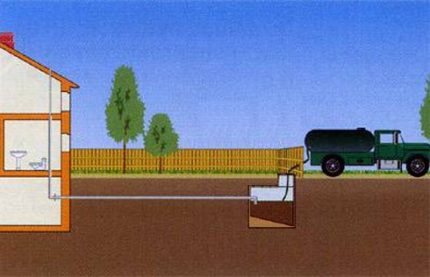
Those and others can be built from inexpensive building or alternative materials, such as:
- factory concrete billets;
- red or white brick;
- cement mortar (to create a sealed monolithic tank);
- car tires.
There is another way, more costly, but quite effective - the installation of a ready-made factory container made of modified plastic, equipped with a pipe for connecting to the pipe, ventilation and a technical hatch.
It is forbidden to dig a drain hole without creating an airtight tank, as this is contrary to sanitary standards. Sewerage, teeming with pathogenic bacteria and chemical aggressive substances, goes straight into the ground and groundwater, polluting them.
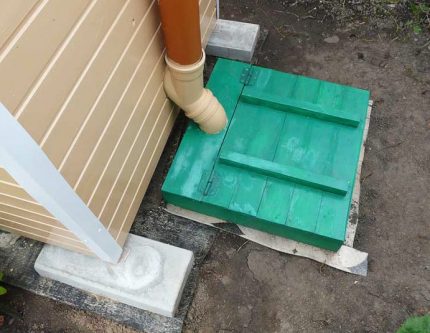
It also makes no sense to install expensive biological treatment plants, since the volume of effluents is likely to be minimal, and the treatment plant will more closely resemble the same storage capacity.
So it turns out that the best option is a volumetric cesspool or structure like a septic tank. On a large area of cesspools there can be several, for example, a peat pit for an outdoor toilet and two drives - at the bathhouse and at home.
Possible sewer schemes
Depending on the number of residents, albeit temporary, the number of plumbing fixtures, the total number of drains, facilities connected to the sewage system, the schemes can be completely different.
Distinctive features are possessed by all parts of the system:
- internal wiring;
- simple or branched pipeline;
- type of pit or septic tank.
Let's consider some of the most popular schemes.
The modern summer cottage is a bit like a utility room or a barn. The owners of even modest suburban areas are trying to build a solid, reliable, roomy housing, so a two-story building has long ceased to be a rarity. The optimal layout for two floors is shown in the diagram:
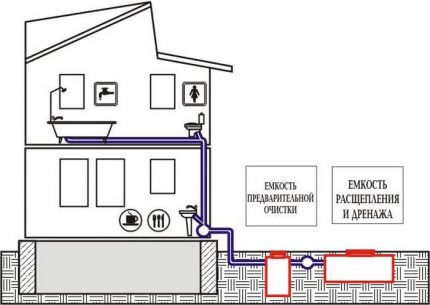
In small one-story houses, usually set a toilet bowl + sink. The shower, if present, is on the street, not far from the garden zone.
Drains from the toilet enter the inner pipe, then go outside and by gravity move to the septic tank.
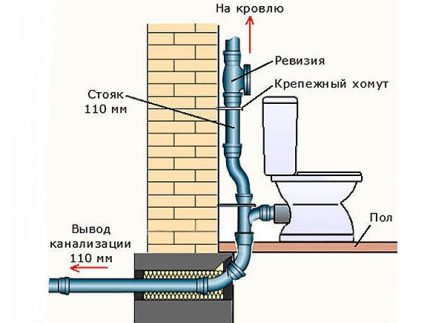
The rake is most often placed near the building, at a distance of 5-10 m. Less than 5 m is not recommended by sanitary standards, more than 10 - difficulties may arise when laying the pipeline. As you know, to ensure the movement of drains by gravity it is necessary sewer slope - about 2 cm per 1 m of the highway.
It turns out that the further the location of the pit, the deeper you have to dig. Too deeply buried container is inconvenient for maintenance.
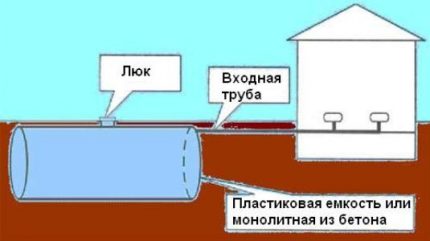
More and more often instead of a cesspool two-chamber septic tank or a cesspool with overflow in the filtering well. It will also be necessary to call the scavengers, but much less often.
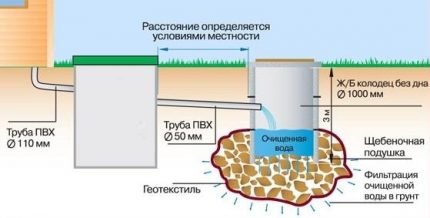
Common schemes of country sewerage can be supplemented by branched internal or external wiring, connecting more waste points, a more effective septic tank, and a filtration field.
Local system building instruction
There is no single plan for the installation of an autonomous sewer network, however, almost any system consists of three main stages - laying pipes inside the house with connecting plumbing fixtures, wiring the outer pipe and a cesspool device (septic tank).
There are exceptions - for example, the complete absence of internal wiring when all hygiene facilities are on the street (shower, toilet, washstand). Consider the full version.
Design based on standards
Half of the success is the correct design, which can be performed in two ways: independently and with the involvement of specialists.
The first method is good when the construction of serious facilities is not planned on the site - a septic tank, a pool, a filtration field, a filtration well. Suppose you are planning to build a street birdhouse, which simultaneously serves as a garbage bin for household waste, and instead of using full-fledged sinks for washing hands and dishes, you decided to install an ordinary washbasin.
To build a toilet on the street, it is enough to dig a hole, equip it with a sealed tank, select the optimal structure scheme and conclude an agreement on regular waste collection.
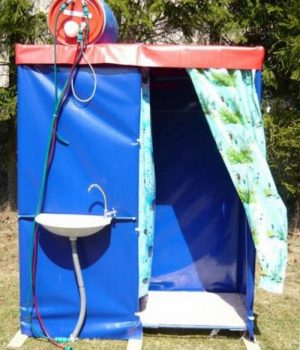
If you plan to make a complex house wiring, install a septic tank, lay pipes from the house, bathhouse and summer kitchen, it is better to contact the engineers who will make a reasonable project based on the layout of the house and landscape features.
In any case, when constructing a drain pit or septic tank, it is necessary to follow the norms of SanPiN, according to which the distances from the waste collection tank to the nearest objects should be as follows:
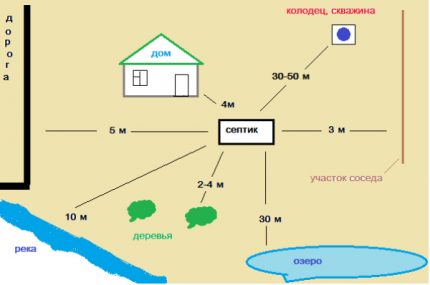
When choosing plumbing and sewer equipment, we also recommend that you rely on technical specifications and GOST standards that govern the use of certain materials.
For example, for laying an external trunk, only special outdoor pipes (smooth and corrugated PVC, PP or HDPE products in orange). Fittings must match pipes by material and diameter.
How to make a house wiring?
The internal wiring diagram includes a network of horizontally arranged pipes that are connected to plumbing fixtures on one side and to a riser on the other. The riser, in turn, is connected to the highway leading to the storage facility.
It is advisable to lay internal communications in the process of building a house - it is easier to equip holes in the walls and mask some parts of the internal pipeline.
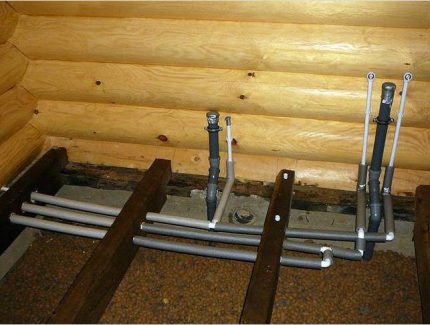
When installing pipes, it is very important to take into account the slope, since in summer cottages special equipment is usually not used, and the movement of the drain water occurs by gravity. The slope value is selected based on the diameter of the pipes: for large (with a diameter of 150 mm) pipes - about 8 mm / linear m, for medium (from 100 to 110 mm) - 20 mm / linear m, for products with a minimum cross section (50 mm ) - 30 mm / linear m.
When installing plumbing, it is recommended to equip water locksthat serve as a trap for bad smell. A shower or sink should be placed higher, and the toilet should be at the lowest point, as close to the riser as possible.
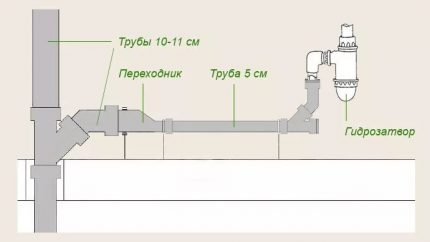
The procedure for connecting and assembling pipes may differ, but usually a riser is mounted first, then pipes are brought in, and plumbing fixtures are connected at the very end.
If a gas or solid fuel boiler is installed in the cottage and a hot water supply system is functioning, the minimum set of toilet bowl + sink is supplemented with a shower or bathtub. Accordingly, the internal branch of the local sewage system for a summer residence will be more difficult in this case.
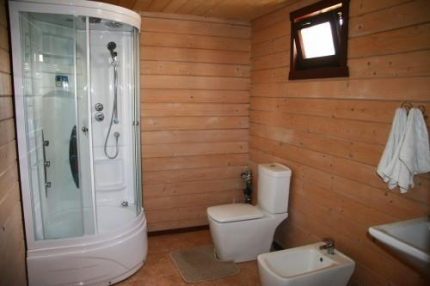
The final moment in laying the house wiring is the device of the adapter in the wall of the house, which is a metal protective sleeve. The ideal solution is the output of the pipe in the foundation of the house into the hole located below the level of freezing of the soil.
Rules for laying external pipes
The choice of pipes of proper quality is not the only condition for a competent laying of the trunk connecting the house network with a cesspool or septic tank. There are rules and regulations that must be followed when deepening communications in the ground.
The first rule relates to the depth of the trench: pipes must be laid below the freezing level so that the liquid sewage system does not freeze and break the pipeline with the onset of cold weather. On the other hand, the depth should not be too large, since it is necessary to withstand the slope - at least 2 cm / 1 m of trenches. It turns out that the difference between the depths of the beginning and the end of the 10-meter groove will be equal to 20 cm.
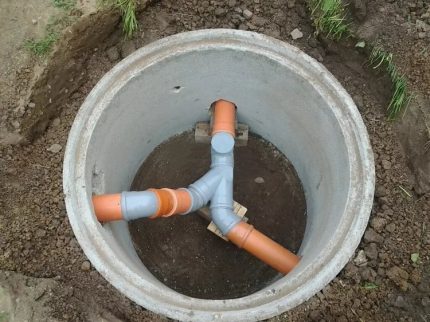
In order not to make the trenches too deep even in the northern regions, pipes are laid at a depth of 50-70 cm, carefully warming all sections.
As a heat insulating material use:
- polystyrene shell;
- foam box;
- basalt fiber;
- mineral wool;
- penoizol;
- foamed polyethylene;
- penofol;
- expanded clay backfill.
In the northern regions, to increase efficiency, materials are combined, for example, they are coated with foamizol pipes and sprinkled with expanded clay on all sides.
There is another way of heating - using electric cable. However, volatile insulation is optimal for permanent homes. For cottages, where it is extremely rare to visit in the cold season, ordinary warming is enough. If the pipes nevertheless freeze and an ice plug forms, it is recommended to try to break it with boiled water.
More information about the rules for laying sewer pipes in the ground can be found in this stuff.
Installation of a cesspool
The order and timing of the arrangement of the drain pit depends on its type. For example, the installation of a factory plastic container is carried out in 1 day, and the construction of a concrete monolithic tank, which involves complete hardening of the solution, lasts at least a month.
Digging a pit can be combined with a trench device and pipe laying. The pit is torn out by the size of the drive, but so that about 0.3 m is left on each side for processing and backfilling. The volume is chosen based on the needs of residents.
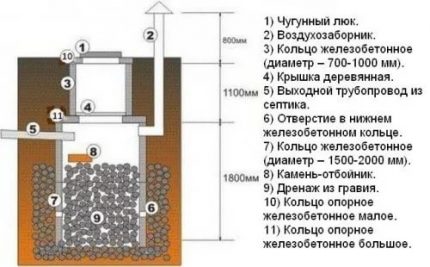
For excavation using construction equipment or shovels with buckets. After clearing the bottom of the pit, the bottom is reinforced with a drainage sand and gravel layer (from 20 to 40 cm thick).
If the tank is light, it is advisable to put a concrete slab on the bottom (or make a concrete screed) and fix the tank with anchors, giving it stability. For the same purpose, dry cement is added to the ground during backfill so that a reliable waterproof ring is formed around the tank.
Prefabricated structures - from bricks, rings, cinder blocks - must be covered with two layers of waterproofing on the outside and inside so that the contents of the tank do not fall into the ground and do not mix with groundwater. Another important condition is the installation of a ventilation riser that removes gases to the outside.
After installation and connection of the pit to the pipeline, they fill up and draw up the neck. The upper hole, which performs technical functions, is closed with a strong lid.
How is a septic tank different from a cesspool?
Many people are interested in how to make an effective sewage system in the country, so that the drainage water not only accumulates in the cesspool, but is also partially purified. The only way to make visits to the scavengers more rare is to install a septic tank, factory or own made, instead of a cesspool.
It is worth distinguishing between two types of septic tanks. Some of them really purify water up to 68 - 97%, because the cleaning process occurs under the influence of anaerobic and aerobic bacteria. The least degree of purification is represented by systems in which waste water is processed by sedimentation and the action of anaerobes.
Complement them filter wells, filtration fields, infiltrators performing soil wastewater treatment.
If aerobes are involved in the operation of the septic system, the second compartment is equipped with a compressor for supplying air and a special load necessary for their fruitful life.
The breeding ground for them is a suspension of clarified sewage, which has moved to the second compartment along the overflow. From systems with aerobic treatment, the most purified water comes out, which can be dumped onto the terrain or into the ground without additional treatment.
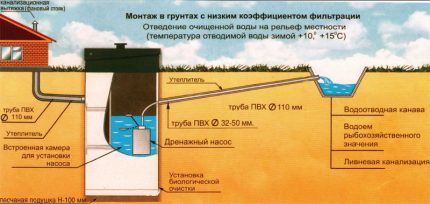
The second view is a two-chamber storage, in which the first chamber also serves to separate fractions, and the second to filter clarified water. The cleaning of the first tank occurs with the same regularity as the removal of waste mass from the cesspool, dirt is less often removed from the second tank. This is usually a gravel pack replacement that replaces the bottom.
It should be remembered that over time, activated sludge accumulates in septic tanks, which in the future can be used as fertilizers. The contents of the cesspool can also be used, but under one condition: if the peat processing technology of waste is observed.
The biological treatment plant is most effective, but an expensive installation, as noted above, is not advisable to use for temporary housing. Therefore, as a sample, we consider the installation instructions for a septic tank from prefabricated concrete prefabricated parts.
Stages of construction of a septic tank made of concrete rings
Installation of a treatment plant for their cylindrical billets takes place according to the standard scheme. The process is simplified due to the large size of the parts, but for the same reason there is a difficulty - the obligatory rental of construction equipment and the participation of a team of workers.
For the construction of a septic tank, 2 sets of parts will be required, since it will consist of two tanks. The function of the first is cumulative, the second is filtering.
The construction of a septic tank from concrete rings is carried out in several standard stages:
Preparation of the pit according to the size of the structure
In the place indicated in the project, with the help of an improvised tool (shovel), a winch or a mini-excavator, they dig a hole in the depth of 2-3 rings + neck. To the height of the assembly assembly, 30-40 cm are added to the base device: 15-20 cm of sand + 15-20 cm of gravel (crushed stone, river pebbles). The drainage layer serves as a reliable basis and a filtering "pillow".
The length of the pit should be such that two tanks are placed in it, connected by a short overflow.
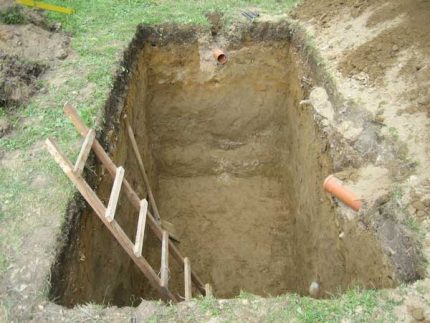
Soil should not be removed from the site - it will come in handy for backfilling. The remains can be used to form landscape objects, for example, flower beds.
Concrete workpiece installation
Concrete rings are mounted one on top of the other, fixed at the joints with brackets and sealed with special gaskets. Manufacturers simplified the installation of the bottom ring of the storage tank - they came up with a blank part with a bottom that does not require additional weighting.
One or two more parts are placed on it, closed with a ceiling with a hole, the neck is placed on top and a technical hatch with a lid is equipped.
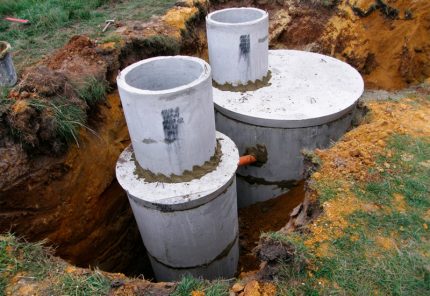
Now there is no need for any individual calculations. The dimensions of the workpieces are standard, and the manufacturer can always find out how much wastewater the selected combination of elements is designed for.
Waterproofing measures
A concrete septic tank of individual parts must be waterproofed. In practice, two methods are used: applying protective material on both sides or applying waterproofing on the outside, and on the inside - only finishing the seams.
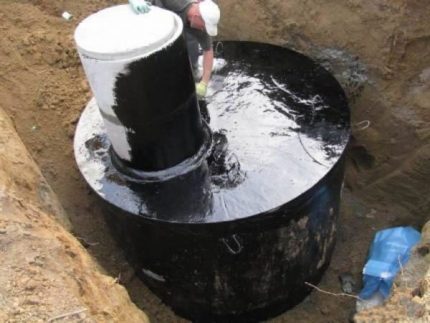
There are modern deeply penetrating materials that surpass the layer of bitumen in technical characteristics (for example, Penetron), but they are more expensive.
Pipe connection and testing
A fully mounted structure is connected into a single whole and connected to a pipe leading from the house. To do this, holes are made in the concrete billets for overflowing - a short length of pipe, then the same hole - for entering the sewer line. All elements are sealed and waterproofed. Take out the vent riser.
To check the operability and tightness of the structure, the first container is filled with water. Then, when the first effluents get into the drive, a bioactivator can be used to make the waste processing process more efficient.
Conclusions and useful video on the topic
To better understand the process of organizing a sewer system, we offer you to watch useful videos.
Secrets of laying external pipes:
Do-it-yourself internal wiring review:
Important points in the construction of a cesspool:
As you can see, for the construction of an autonomous sewage system, certain engineering knowledge and skills are needed at your dacha. If in doubt, it is better to seek the help of specialists: there are many companies that are successfully involved in the design and installation of local sewer systems.
Do you have experience in arranging sewage in the country? Please share practical advice with our readers, tell us what you need to pay attention to when arranging an autonomous system - the feedback form is located under the article.

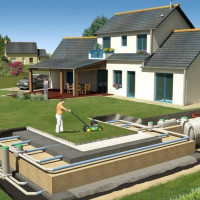 How to make a sewer of a country house with your own hands: the best schemes and options for arranging
How to make a sewer of a country house with your own hands: the best schemes and options for arranging 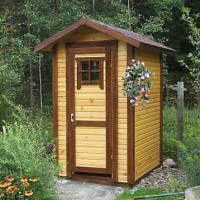 DIY toilet in the country: step-by-step instructions for building
DIY toilet in the country: step-by-step instructions for building 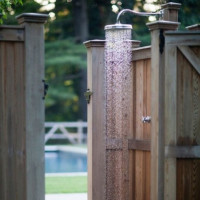 How to make a summer shower with your own hands: schemes of common designs
How to make a summer shower with your own hands: schemes of common designs 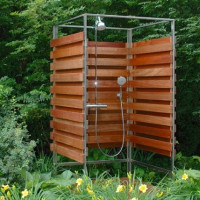 DIY garden shower: technology features and main stages of construction
DIY garden shower: technology features and main stages of construction 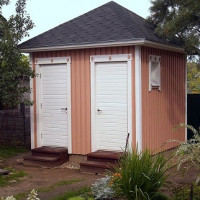 The design of the country toilet with shower: the choice of the scheme and instruction on the construction
The design of the country toilet with shower: the choice of the scheme and instruction on the construction 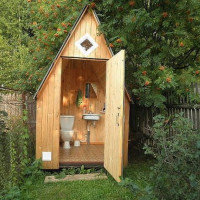 Drawing of a country toilet: popular building schemes for an independent project
Drawing of a country toilet: popular building schemes for an independent project  How much does it cost to connect gas to a private house: the price of organizing gas supply
How much does it cost to connect gas to a private house: the price of organizing gas supply  The best washing machines with dryer: model rating and customer tips
The best washing machines with dryer: model rating and customer tips  What is the color temperature of light and the nuances of choosing the temperature of the lamps to suit your needs
What is the color temperature of light and the nuances of choosing the temperature of the lamps to suit your needs  Replacement of a geyser in an apartment: replacement paperwork + basic norms and requirements
Replacement of a geyser in an apartment: replacement paperwork + basic norms and requirements
A person who understands at least a little the principle of the sewage system does not have problems organizing in its independent organization. But unfortunately, I'm not like that, for me it's all very complicated. Therefore, even for a summer residence, on which we visit by force 5 times a year, I called specialists for such work. They dug a large trench, laid pipes and installed a septic tank. It is enough, because we do not live here.
So it turns out that all the rubbish from the sewer (detergents, etc.) are absorbed into the ground and poison the environment ... Where is the cleaning or filtration system ?? And we live in the country for six months and we have two drinking wells, into which these sewages can fall ... Horror!
Of course, if you do it “the old fashioned way”, namely, an ordinary cesspool, then this is far from safe. Sewage can get into groundwater, as well as into a well and generally anywhere. Therefore, people who have been living in country houses where there is no central sewage system for a long time or on a permanent basis have recently abandoned such unsafe decisions.
In fact, if you look at the future, then installing septic tanks (ready-made or erected on your own), this is beneficial, since there will be no pollution on the site. The article presents both complex and simple budget decisions. In any case, a filtration system should be present.